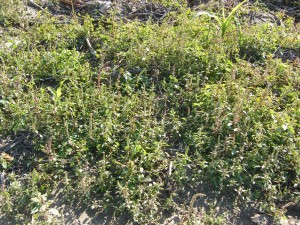by Muthu Bagavathiannan, Assistant Professor of Weed Science, College Station; Peter Dotray, Professor of Weed Science, Lubbock; Paul Baumann, Extension Weed Specialist, College Station; Gaylon Morgan, State Cotton Specialist, College Station
Palmer amaranth and waterhemp (known as pigweeds) have been spreadling rapidly in Texas row crops and several of these populations are likely resistant to glyphosate heribicide. Producers are increasingly recognizing the importance of preplant and pre-emergence residual herbicides and multiple modes of action to help prevent/manage glyphosate resistant pigweeds in their fields. However, much of the emphasis is focused on in-season management of pigweeds, while little attention has been given to managing late-season weed flushes that come up at and after crop harvest.
Pigweeds have a tremendous ability to emerge season-long, which includes after crop harvest following rainfall or irrigation events. Depending on the location and crop grown, there may be ample time for late-emerging pigweeds to produce mature seed prior to a killing frost. In particular, there is a huge potential for pigweed seed production in Texas following the harvest of corn, sorghum and other early-planted crops. Pigweeds can flower even when they are only few inches tall and only need about two weeks from flowering to seed maturity.
Experiments were conducted in College Station and Lubbock to understand the seed production potential of Palmer amaranth (both locations) and waterhemp (College Station) as they emerge at different dates late-season. Pigweed seedlings were monitored weekly starting August 19 in College Station and September 11 in Lubbock, at which point the majority of corn and sorghum were already harvested in these regions. The first flush of Palmer amaranth that came up after crop harvest produced on average about 20,000 seeds/plant in College Station and 500 seeds/plant in Lubbock. Palmer amaranth produced mature seeds even when they emerged as late as mid- to late October in both locations, with about 10 to 20 seeds/plant. Likewise, waterhemp produced about 800 seeds/plant when they emerged during the first week of September in College Station and seed production continued for as late as mid-October (about 8 seeds/plant).
These observations are noteworthy because even if a pigweed plant only produces few seeds, considering the tens of thousands of pigweeds that emerge in an infested field, there will be millions of seeds going back to the soil. Given the damage that pigweeds cause to crop production, even these small numbers of seed can make a significant impact in future growing seasons. It is extremely important that growers include post-harvest pigweed management as part of their weed management program. It may mean an additional pass of herbicide application and/or cultivation, but the efforts are well worth it and is a good investment in terms of better weed control and yield protection in the subsequent season. Growers may use herbicides such as Liberty Gramoxone, or MSMA tank-mixed with a residual herbicide such as Dual, Warrant, or Direx for longer pigweed control. Future cotton technologies may allow late in-season use of 2,4-D Choline and/or dicamba. Be sure to spray the weeds when they are less than 2-3 inches tall and keep the plant-back interval in mind while choosing residual herbicides. As always, please read and follow label instructions when making applications.

Assistant Professor Weed Science and Agronomy Texas A&M AgriLife Research College Station, TX muthu@ag.tamu.edu 979-845-5375
